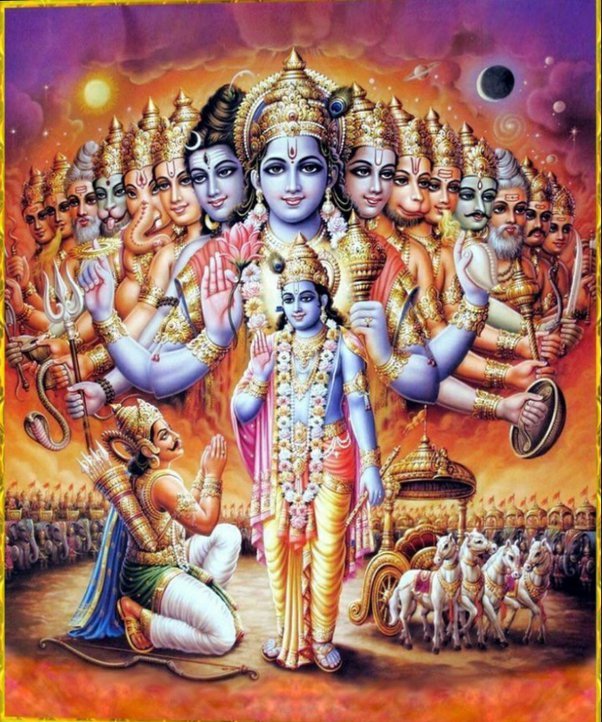August: The Power Of Myth
We’re rounding the corner on summer, Galactic Buddies! My kids actually start school in just over two weeks, believe it or not! I only did a fraction of what I wanted to do this summer, but I’m also going to push back against the notion of time as depicted on the calendar, reminding myself that some of the Midwest’s most beautiful weather comes in September and October. So I’ve still got some swimming and long bike rides awaiting me, I think, and I hope you’ll remember to keep summering even when the calendar announces that it’s technically fall.
And speaking of the relativity of time, I’ve been pondering The Bhagavad Gita for the past couple of weeks, which brought me around to our theme this month: The Power of Myth. The Gita comes to us from the larger epic of the Mahabharata, and takes place on a battlefield, in a war between the Pandavas and the Kauravas, as the warrior Arjuna despairs and doubts whether he is able to go into battle against his kin on the other side.
His charioteer turns out to be Lord Krishna, who then discourses with Arjuna on the nature of the universe, the nature of God, our duties and devotions during our time on earth, the various types of yoga, dharma, karma and more. As Krishna and Arjuna dialogue on the battlefield, time seems to stop. Krishna reveals himself in his universal form, called Vishavarupa, where he embodies the entire universe, and he says, in some translations of the Gita “I am Time, the destroyer of worlds,” which might sound a bit familiar to you if you’re tuned into one of our current cinematic zeitgeists: Oppenheimer.
In my favorite translation of this sloka, or verse, Stephen Mitchell translates it thus:
“ I am death, shatterer of worlds,
annihilating all things.
With or without you, these warriors
in their facing armies will die.”
-Bhagavad Gita, Chapter 11, Verse 32
If you’re living under a rock and not aware of who Robert Oppenheimer is, he was the father of the atomic bomb who was a fervent scholar of the Gita, and had a penchant for mysticism. It’s not known if he actually uttered the phrase “Now I am become Death, the destroyer of worlds” as he witnessed the destructive power of his creation, but it’s become wrapped up in his legacy as a brilliant mind that created a horrendous weapon and struggled to grapple with that legacy.
Whether you interpret this sloka, as Krishna revealing himself as the unstoppable destructive force of time, or death itself, what I find fascinating is that, in order to grapple with the complexities of his place in the terrible course of events, Oppenheimer referenced a myth, or a story, and fit himself into that story’s narrative.
Which, we actually all do, all the time. The writer Elie Wiesel says that God created man because God liked hearing stories, and I love that idea. We strive to make meaning of our sometimes illogical, unexplainable, tragic, and glorious worlds, and from that meaning-making, story-striving, we produce brilliant works of art - like the Iliad (ask me about how much I love Hector), or Beowulf or even the Marvel Universe! I truly believe, one day far in the future, the Marvel Universe will be used as a mythology of our times, helping future humans to understand just what it was like to live in the early 21st century.
One of my favorite Star Trek: The Next Generation Episodes is called Darmok, and it’s about an alien race called the Tamarians, whose entire language is not translatable via the universal translators.
The aliens keep saying phrases like “Darmok and Jilad at Tanagra,” and “Shaka, when the walls fell,” and not being understood.
Picard ends up being taken by the Tamarian’s leader to a planet, where they face off against a beast and ultimately destory it. Over the course of the hour, it’s discovered that the Tamarians’ language is made entirely of metaphorical allusions to their mythology, which was why it was so hard to translate. When they triumph over the beast, the Tamarian leader asks Picard to tell him a story from Earth’s mythology, and he shares the story of Gilgamesh and Enkidu at Uruk, a similar story where two heroes grow closer through hardship.
There’s so much to nerd out over in that episode, and I often do, because I love Star Trek: TNG with the passionate fire of a thousand burning suns. But the idea of character building through the shared experience of living through or telling our shared mythical stories hits SO DEEP.
Joseph Campbell talks about it all the time in his works on myth and the Hero’s Journey, as does Jung when he explores the concept of shadow in the Grimm Fairy Tales. There are so many ways to listen to stories and have them help us to understand the contours of our own psyche and to work through our own trials, and….
I just have to go here…
…the Barbie movie and the legacy of Barbie is just another way that many of us literally acted out our stories as youngsters, which brings me to one of my favorite stories about my childhood, as told by my Dad: THE LAST TIME ANNA PLAYED WITH BARBIES. And trust that there were several Weird Barbies like Kate McKinnon present during this little personal mythological momen
My best friend, Sarah, and I had known each other since Kindergarten, and had just entered into Junior High, which started for us in 7th grade. It was 1991. We were slightly diverging on our paths, as I went the way of the theatre nerd, and she pursued other interests. You know those fork in the road moments, where you know a friendship is going to change, and you’re sad about it, but there’s nothing you can do to change it? It was like that.
One day, Sarah came over to my house. I had a huge box of Barbies in my closet that we hadn’t touched in ages. For some reason, both of us decided that we were going to play Barbies together. My Dad said that we played for well over an hour. He listened to us, upstairs in my room, acting things out, getting the Barbies and Kens dressed, laughing, talking, and he felt like he was witnessing a rite of passage, or some way that the two of us intuitively devised to be able to narrate this change in our friendship that was inevitable, but new. The Barbies helped us say goodbye to our childhood friendship, to acknowledge that our relationship was changing, and to process what we were feeling in a way that felt easy, like play.
In the yoga studio, we have asanas that literally are shaped like the gods, goddesses, sages, mystics and animals that populate India’s rich history of epics, philosophical texts, and spirituality that is an undercurrent to our practice - I can’t wait to share those stories with you as we literally embody them in our practice.
When I see you in the studio over the next month, I want to hear your stories! What are your favorite myths? What are your favorite Marvel movies? What’s your favorite Greek epic? Favorite Grimm fairy tale? Ghost story? What are some myths I need to know about that I don’t know about?
And, if you’re wondering if there’s a Tori Amos song that perfectly narrates my journey into adolescence via my Barbie story above, there is. It’s called “Bells For Her,” and it makes me cry every time I listen to it. I hope you feel the story that Tori tells as deeply as I did when I first heard it - and maybe the telling helps us find our own way through.
Can’t stop what’s coming, can’t stop what is on its way.
Anna
What I’m Reading
It was hard for me to pick just one book this month, because I love a good myth, and I love a good retelling of a myth, so here are a few of my mythical favorites:
Sir Gawain and The Green Knight, trans. Simon Armitage
This is my top pick for the month - this Armitage translation is poppin, and I haven’t watched the 2021 movie, yet, so I’ll probably do a nice pairing of the two.
Tilll We Have Faces, C.S. Lewis
This is a C.S. Lewis retelling of the myth of Cupid and Psyche, which he badly wanted to retell to account for the somewhat illogical actions of Psyche’s sisters. I enjoy this retelling, even though I have feelings about C.S. Lewis’s obsession with physical beauty and the “dangers” of it. Let’s talk about it, if you do, too.
Shadow and Evil In Fairy Tales, Marie-Louie von Franz
This book is a scholarly and psychological exploration of the symbolism of fairy tales, and what it can reveal about our own selves, particularly our shadow selves. I’m a fanatic for anything Jungian (just wait until we devote the entire month of October to embracing the shadow), and have a deep, ancestral-feeling connection to the stories of the Grimm brothers, so this is always a favorite to read and re-read, for inspiration and introspection.







